Effects of Gradient Hot Rolled Deformation on Texture Evolution and Properties of 1561 Aluminum Alloy
Abstract
:1. Introduction
2. Experimental
2.1. Material and Processing
2.2. Characterizations and Testing
3. Results and Discussion
3.1. Grain Morphology and Grain Size
3.2. Micro-Texture
3.3. Mechanical Properties of Annealed 1561 Aluminum Alloy
3.4. The Dislocation Density of Annealed 1561 Aluminum Alloy
4. Conclusions
- (1)
- After gradient hot rolling, the microstructure of the hot rolled 1561 aluminum alloy consists of elongated grains and equiaxed grains, and the average grain size is 18.95 μm at the 3% deformation plate, while the average grain size of 30% deformation plate is 1.19 μm. Respectively, after annealing, the average grain size decreased from 28.34 μm to 10.69 μm in the hot rolling process. Work hardening, fine-grain strengthening and texture influence the mechanical properties of the hot rolled 1561 aluminum alloy together.
- (2)
- The most prevalent textures in the 1 plate are <110> Cubic and (110) <110> R-Goss textures, accounting for 11.8 vol.% and 7.23 vol.%, respectively. The most prevalent textures in the 2 plate are <111> Cubic, <100> Cubic, (110) <100> Goss, (110) <112> Brass, (123) <634> S textures, accounting for 18.9 vol.%, 17.9 vol.%, 15 vol.%, 5.64 vol.%, and 9.85 vol.%. Respectively, the accumulated deformation results in the above-mentioned difference in the 1 and 2 plates. Moreover, the fraction of fiber component is higher than that of other components in all plates. Texture produced by gradient deformation has a synergistic effect on the mechanical properties of the annealed hot rolled 1561 aluminum alloy.
- (3)
- With the increment of deformation, the hardness value increased from 83.8 HV up to as high as 104 HV, and the electrical conductivity value increased from 23.5 %IACS to 24.3 %IACS. The dislocation density up 2.62 × 1014 m−2 to 2.86 × 1014 m−2 with the growth of deformation. After gradient hot rolling at 450 °C, the number of deformations increases, the shear stress increases, a large number of dislocations multiply and interact, and the dislocation density increases rapidly.
Author Contributions
Funding
Institutional Review Board Statement
Informed Consent Statement
Data Availability Statement
Conflicts of Interest
References
- Toros, S.; Ozturk, F.; Kacar, I. Review of warm forming of aluminum–magnesium alloys. J. Mater. Process. Technol. 2008, 207, 1–12. [Google Scholar] [CrossRef]
- Polmear, I.J. Recent Developments in Light Alloys. Mater. Trans. JIM 1996, 37, 12–31. [Google Scholar] [CrossRef] [Green Version]
- Heinz, A.; Haszler, A.; Keidel, C.; Moldenhauer, S.; Benedictus, R.; Miller, W.S. Recent development in aluminium alloys for aerospace applications. Mater. Sci. Eng. A 2000, 280, 102–107. [Google Scholar] [CrossRef]
- Guo, M.X.; Zhang, X.K.; Zhang, J.S.; Zhuang, L.Z. Effect of Zn addition on the precipitation behaviors of Al–Mg–Si–Cu alloys for automotive applications. J. Mater. Sci. 2017, 52, 1390–1404. [Google Scholar] [CrossRef]
- Dongxia, Y.; Xiaoyan, L.; Dingyong, H.; Hui, H. Effect of minor Er and Zr on microstructure and mechanical properties of Al–Mg–Mn alloy (5083) welded joints. Mater. Sci. Eng. A 2013, 561, 226–231. [Google Scholar] [CrossRef]
- McShane, H.B.; Lee, C.P.; Sheppard, T. Structure, anisotropy, and properties of hot rolled AA 5083 alloy. Mater. Sci. Technol. 1990, 6, 428–440. [Google Scholar] [CrossRef]
- Li, H.; Wang, H.; Liang, X.; Wang, Y.; Liu, H. Effect of Sc and Nd on the Microstructure and Mechanical Properties of Al-Mg-Mn Alloy. J. Mater. Eng. Perform. 2010, 21, 83–88. [Google Scholar] [CrossRef]
- Ning, J.L.; Jiang, D.M. Influence of Zr addition on the microstructure evolution and thermal stability of Al–Mg–Mn alloy processed by ECAP at elevated temperature. Mater. Sci. Eng. A 2007, 452–453, 552–557. [Google Scholar] [CrossRef]
- She, X.W.; Jiang, X.Q.; Wang, P.Q.; Tang, B.B.; Chen, K.; Liu, Y.J.; Cao, W.N. Relationship between microstructure and mechanical properties of 5083 aluminum alloy thick plate. Trans. Nonferrous Met. Soc. China 2020, 30, 1780–1789. [Google Scholar] [CrossRef]
- Ebenberger, P.; Uggowitzer, P.J.; Gerold, B.; Pogatscher, S. Effect of Compositional and Processing Variations in New 5182-Type AlMgMn Alloys on Mechanical Properties and Deformation Surface Quality. Materials 2019, 12, 1645. [Google Scholar] [CrossRef] [Green Version]
- Vlach, M.; Stulikova, I.; Smola, B.; Piesova, J.; Cisarova, H.; Danis, S.; Plasek, J.; Gemma, R.; Tanprayoon, D.; Neubert, V. Effect of cold rolling on precipitation processes in Al–Mn–Sc–Zr alloy. Mater. Sci. Eng. A 2012, 548, 27–32. [Google Scholar] [CrossRef]
- Gras, C.; Meredith, M.; Hunt, J. Microstructure and texture evolution after twin roll casting and subsequent cold rolling of Al–Mg–Mn aluminium alloys. J. Mater. Process. Technol. 2005, 169, 156–163. [Google Scholar] [CrossRef]
- Kim, B.H.; Lee, J.Y.; Yoon, Y.O.; Kim, S.K. Effects of Mg and Mn Contents on Hot-Rolling Temperature and Resultant Tensile Properties of Al-Mg-Mn Alloys. Mater. Sci. Forum 2016, 877, 334–339. [Google Scholar] [CrossRef]
- Li, X.; Xia, W.; Yan, H.; Chen, J.; Su, B.; Song, M.; Li, Z.; Lu, Y. High strength and large ductility of a fine-grained Al–Mg alloy processed by high strain rate hot rolling and cold rolling. Mater. Sci. Eng. A 2020, 787, 139481. [Google Scholar] [CrossRef]
- Jin, Z.-Z.; Cheng, X.-M.; Zha, M.; Rong, J.; Zhang, H.; Wang, J.-G.; Wang, C.; Li, Z.-G.; Wang, H.-Y. Effects of Mg17Al12 second phase particles on twinning-induced recrystallization behavior in Mg-Al-Zn alloys during gradient hot rolling. J. Mater. Sci. Technol. 2019, 35, 2017–2026. [Google Scholar] [CrossRef]
- Robert, W.; Piot, D.; Driver, J. A rapid deformation texture model incorporating grain interactions. Scr. Mater. 2004, 50, 1215–1219. [Google Scholar] [CrossRef]
- She, X.; Jiang, X.; Zhang, R.; Wang, P.; Tang, B.; Du, W. Study on microstructure and fracture characteristics of 5083 aluminum alloy thick plate. J. Alloy. Compd. 2020, 825, 153960. [Google Scholar] [CrossRef]
- Choi, S.H.; Song, Y.; Kim, J.K.; Kim, H.W.; Kang, S.B. Texture Evolution during Hot Rolling Deformation in Al-5wt%Mg Alloy. Key Eng. Mater. 2007, 89–92. [Google Scholar] [CrossRef]
- Takebayashi, S.; Kunieda, T.; Yoshinaga, N.; Ushioda, K.; Ogata, S. Comparison of the Dislocation Density in Martensitic Steels Evaluated by Some X-ray Diffraction Methods. ISIJ Int. 2010, 50, 875–882. [Google Scholar] [CrossRef] [Green Version]
- Aufrecht, J.; Leineweber, A.; Foct, J.; Mittemeijer, E. The structure of nitrogen-supersaturated ferrite produced by ball milling. Philos. Mag. 2008, 88, 1835–1855. [Google Scholar] [CrossRef] [Green Version]
- Stokes, A.R. A Numerical Fourier-analysis Method for the Correction of Widths and Shapes of Lines on X-ray Powder Photographs. Proc. Phys. Soc. 1948, 61, 382–391. [Google Scholar] [CrossRef]
- Williamson, G.K.; Hall, W.H. X-ray line broadening from filed aluminium and wolfram. Acta Metall. 1953, 1, 22–31. [Google Scholar] [CrossRef]
- Shintani, T.; Murata, Y. Evaluation of the dislocation density and dislocation character in cold rolled Type 304 steel determined by profile analysis of X-ray diffraction. Acta Mater. 2011, 59, 4314–4322. [Google Scholar] [CrossRef]
- Su, Y.; Chen, B.; Tan, C.; Song, X.; Feng, J. Influence of composition gradient variation on the microstructure and mechanical properties of 316 L/Inconel718 functionally graded material fabricated by laser additive manufacturing. J. Mater. Process. Technol. 2020, 283, 116702. [Google Scholar] [CrossRef]
- Liang, Y.; Xiang, S.; Li, T.; Zhang, X. Ultrafast fabrication of high-density Al–12Si compacts with gradient structure by electro-discharge sintering. J. Manuf. Process. 2020, 54, 301–308. [Google Scholar] [CrossRef]
- Wang, X.J.; Sun, W.; Chen, J.F.; Wang, F.Y.; Li, L.; Cui, J.Z. Microstructures and properties of 6016 aluminum alloy with gradient composition. Rare Met. 2021, 40, 2154–2159. [Google Scholar] [CrossRef]
- Liu, Z.; Meyers, M.A.; Zhang, Z.; Ritchie, R.O. Functional gradients and heterogeneities in biological materials: Design principles, functions, and bioinspired applications. Prog. Mater. Sci. 2017, 88, 467–498. [Google Scholar] [CrossRef]
- Boldetti, C.; Pinna, C.; Howard, I.C.; Gutierrez, G. Measurement of deformation gradients in hot rolling of AA3004. Exp. Mech. 2005, 45, 517–525. [Google Scholar] [CrossRef]
- Li, X.; Lu, L.; Li, J.; Zhang, X.; Gao, H. Mechanical properties and deformation mechanisms of gradient nanostructured metals and alloys. Nat. Rev. Mater. 2020, 5. [Google Scholar] [CrossRef]
- Chen, L.; Yuan, F.; Jiang, P.; Xie, J.; Wu, X. Mechanical properties and deformation mechanism of Mg-Al-Zn alloy with gradient microstructure in grain size and orientation. Mater. Sci. Eng. A 2017, 694, 98–109. [Google Scholar] [CrossRef] [Green Version]
- Lebensohn, R.A.; Brenner, R.; Castelnau, O.; Rollett, A.D. Orientation image-based micromechanical modelling of subgrain texture evolution in polycrystalline copper. Acta Mater. 2008, 56, 3914–3926. [Google Scholar] [CrossRef]
- Fan, X.; Tang, D.; Fang, W.; Li, D.; Peng, Y. Microstructure development and texture evolution of aluminum multi-port extrusion tube during the porthole die extrusion. Mater. Charact. 2016, 118, 468–480. [Google Scholar] [CrossRef]
- Hirsch, J.; Lücke, K. Overview no. 76: Mechanism of deformation and development of rolling textures in polycrystalline f.c.c. metals—I. Description of rolling texture development in homogeneous CuZn alloys. Acta Met. 1988, 36, 2863–2882. [Google Scholar] [CrossRef]
- Lücke, K.; Engler, O. Effects of particles on development of microstructure and texture during rolling and recrystallisation in fcc alloys. Mater. Sci. Technol. 1990, 6, 1113–1130. [Google Scholar] [CrossRef]
- Liu, W.; Man, C.-S.; Morris, J. Lattice rotation of the cube orientation to the β fiber during cold rolling of AA 5052 aluminum alloy. Scr. Mater. 2001, 45, 807–814. [Google Scholar] [CrossRef]
- Zhang, Z.; Zhou, F.; Lavernia, E.J. On the analysis of grain size in bulk nanocrystalline materials via x-ray diffraction. Met. Mater. Trans. A 2003, 34, 1349–1355. [Google Scholar] [CrossRef]
- Williamson, G.K.; Smallman, R.E., III. Dislocation densities in some annealed and cold-worked metals from measurements on the X-ray debye-scherrer spectrum. Philos. Mag. 1956, 1, 34–46. [Google Scholar] [CrossRef]
- Zhao, Y.; Liao, X.; Jin, Z.; Valiev, R.; Zhu, Y. Microstructures and mechanical properties of ultrafine grained 7075 Al alloy processed by ECAP and their evolutions during annealing. Acta Mater. 2004, 52, 4589–4599. [Google Scholar] [CrossRef]
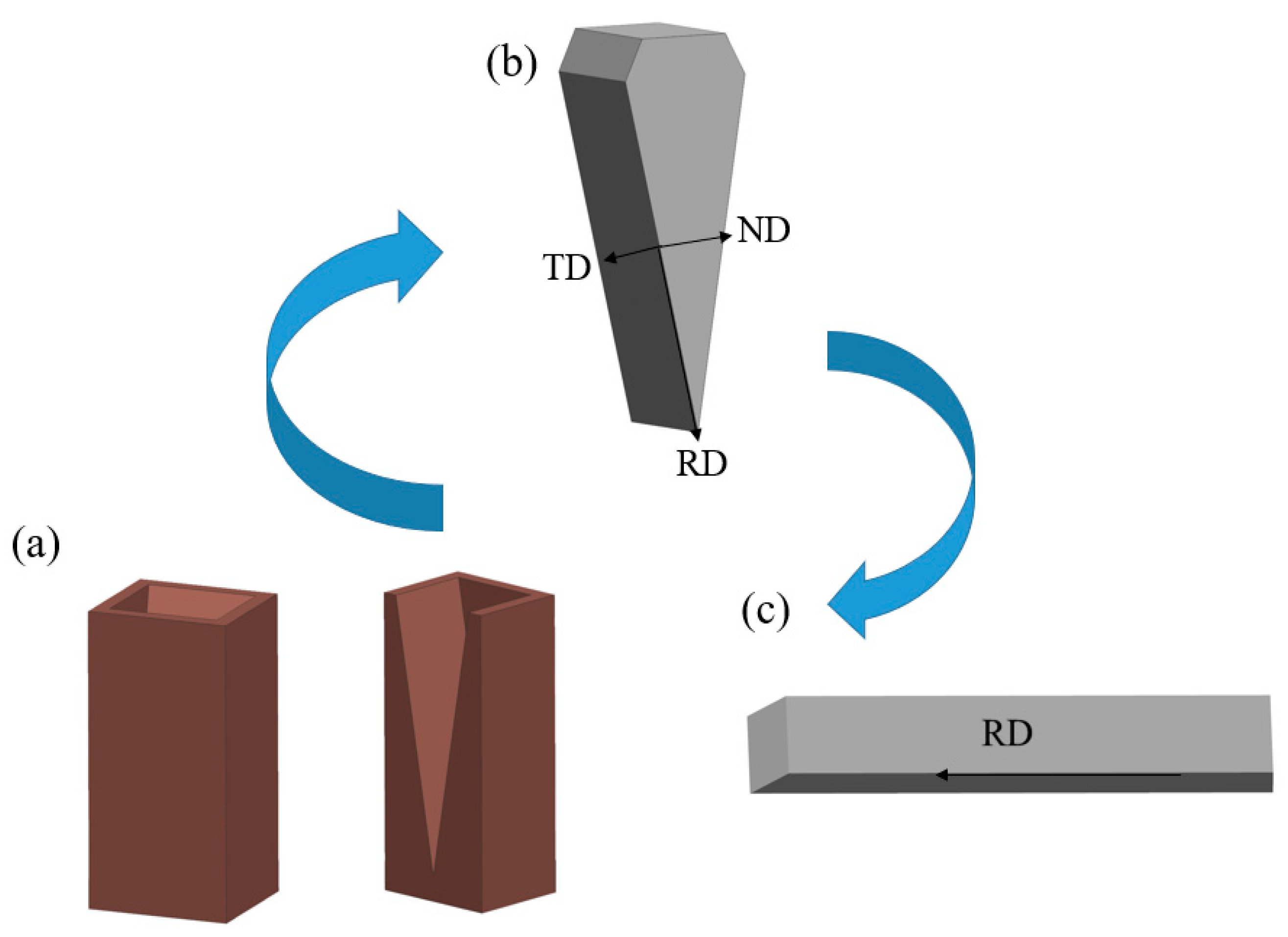
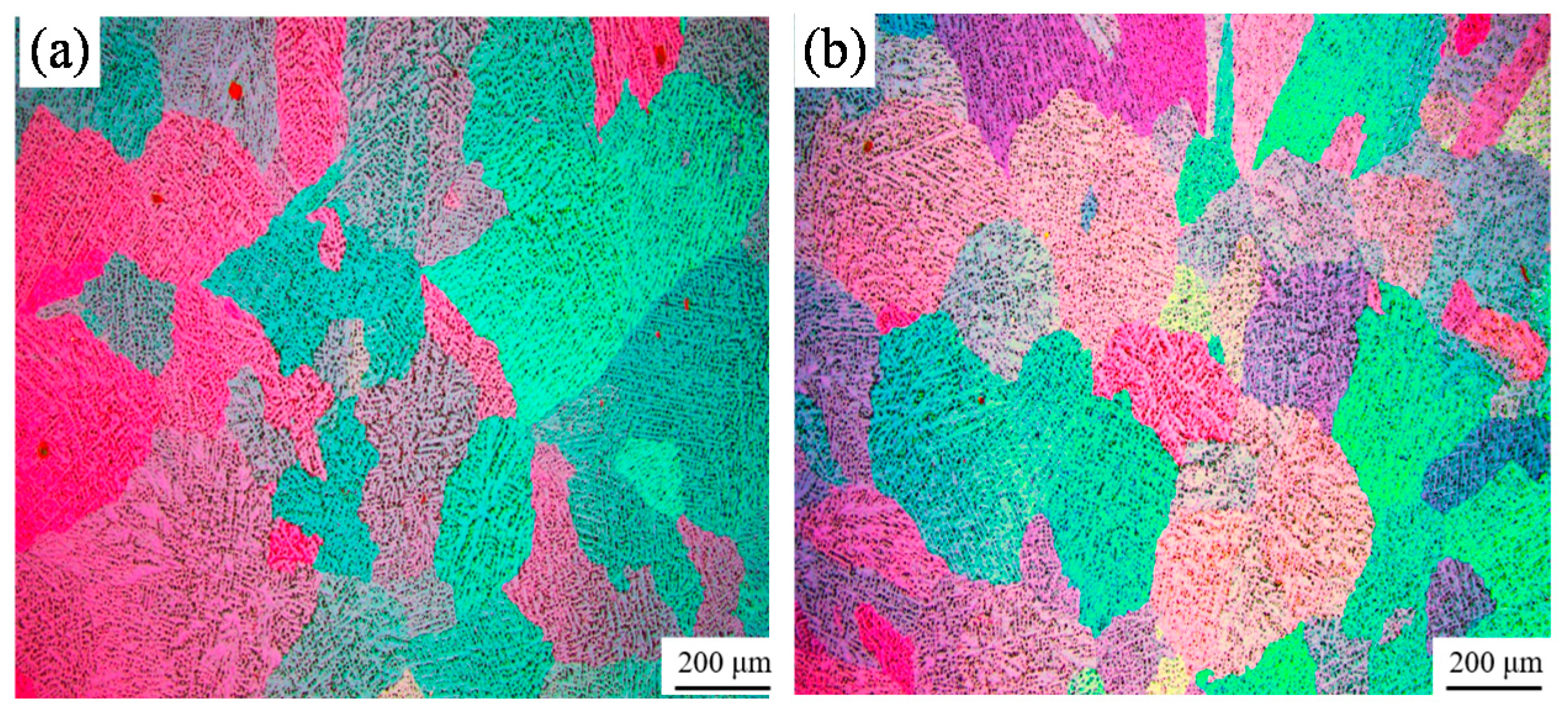
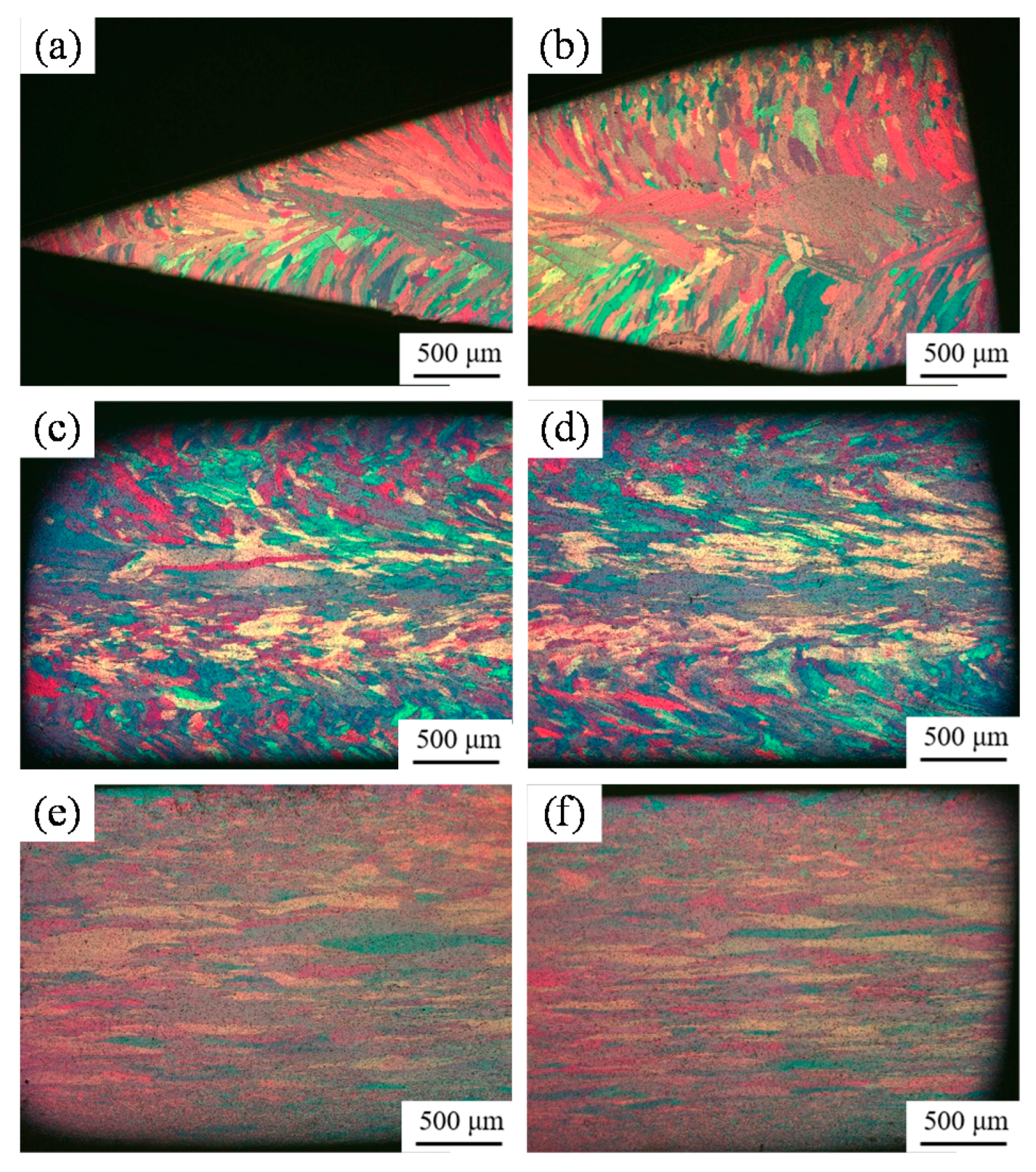
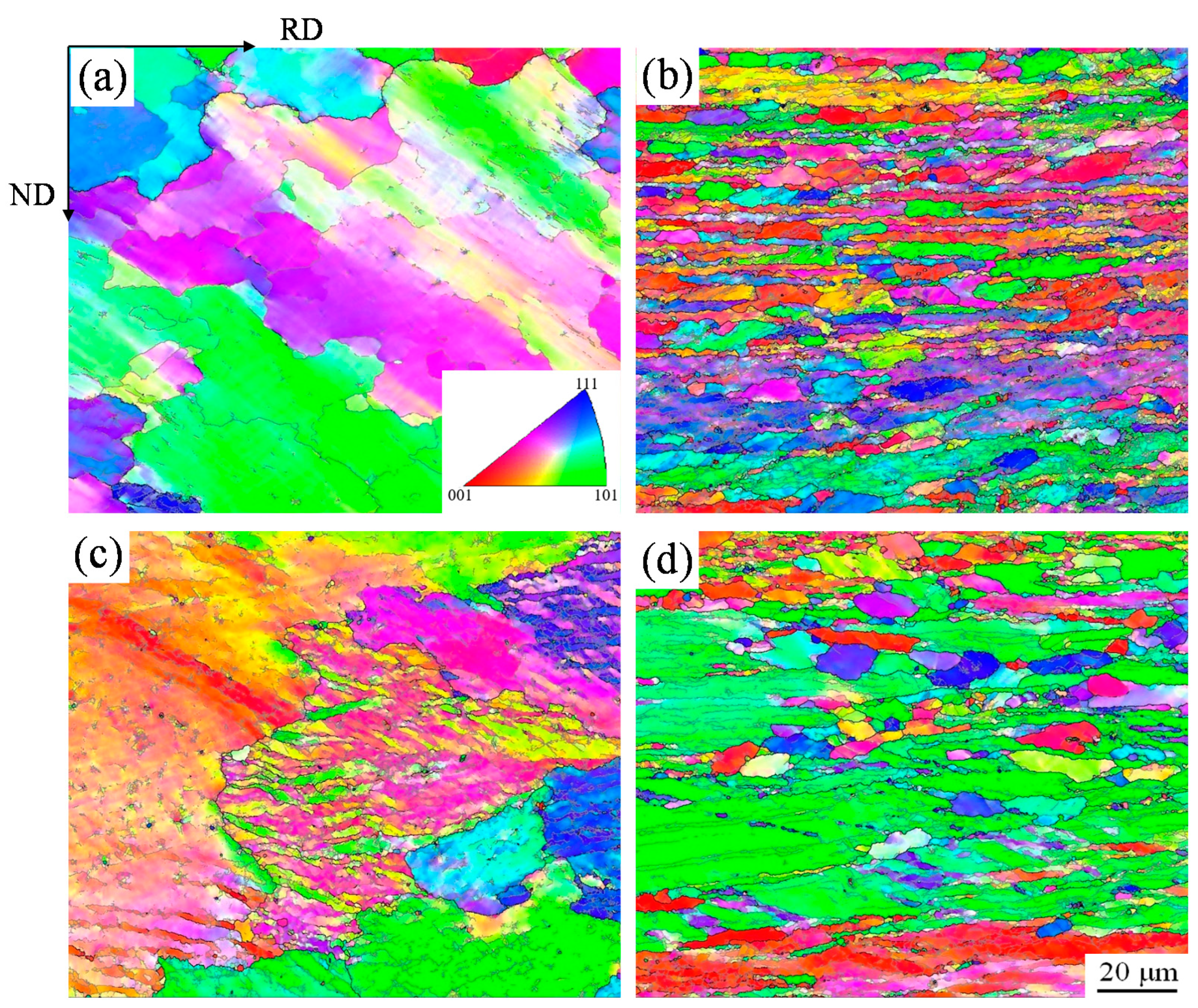

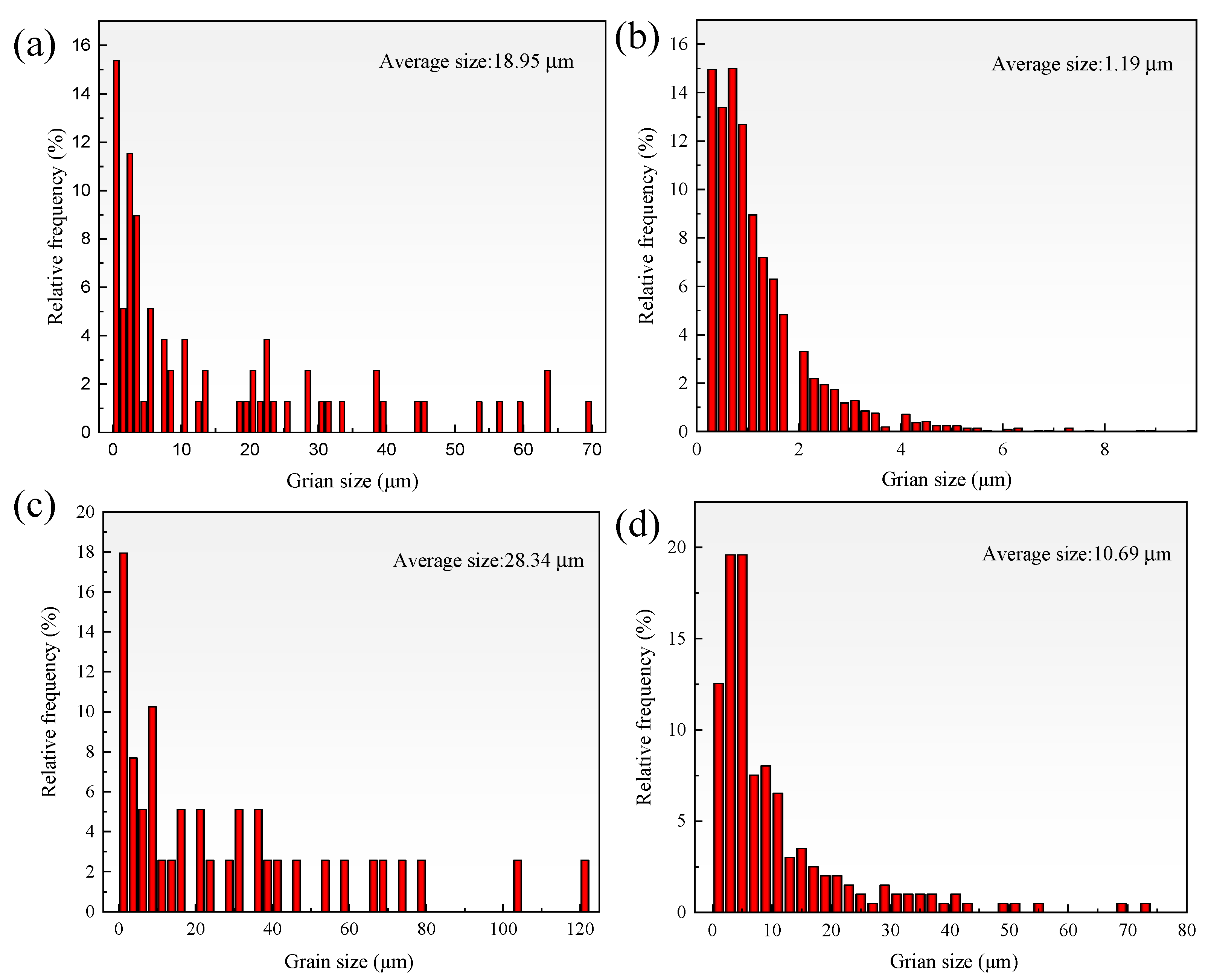

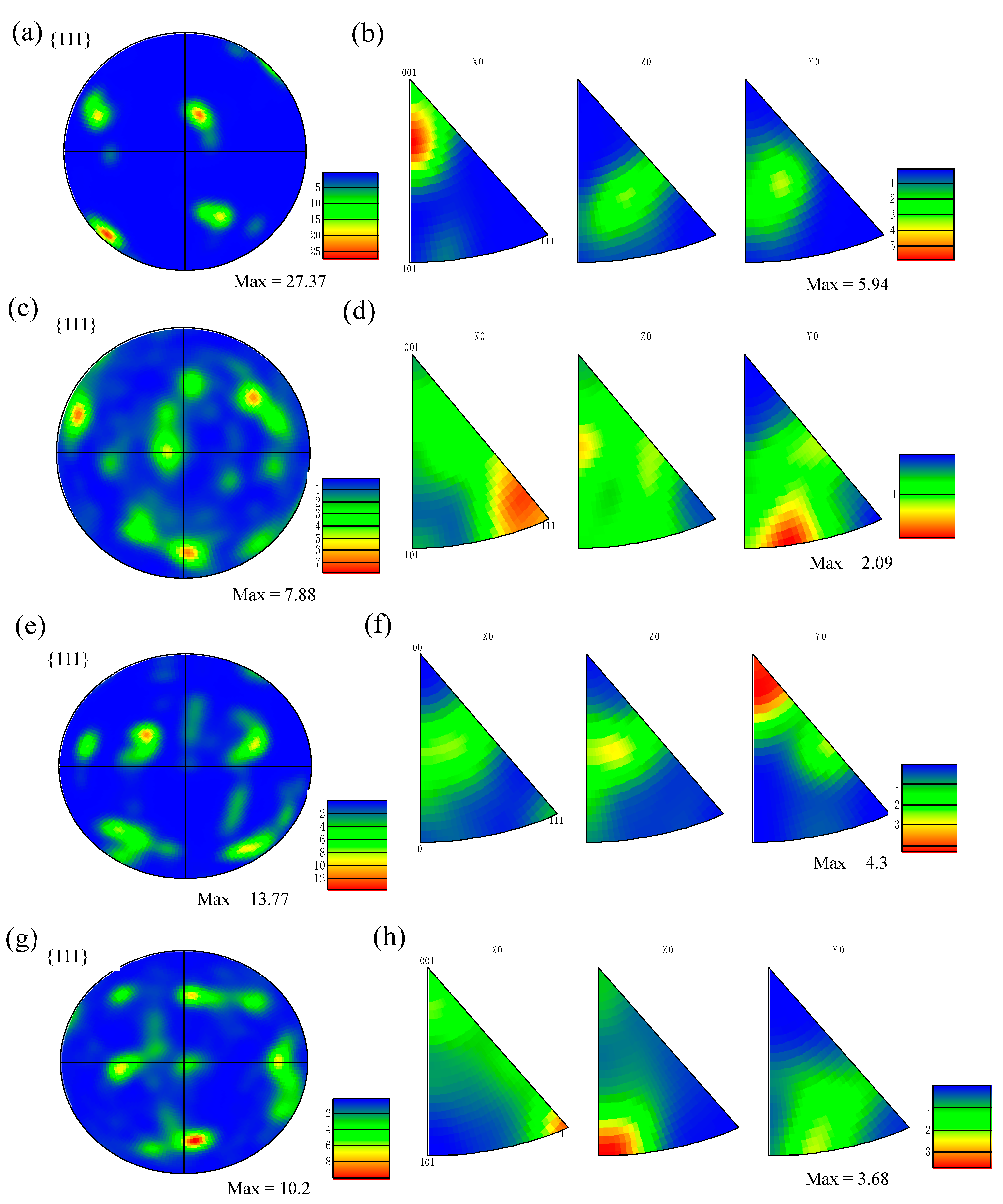
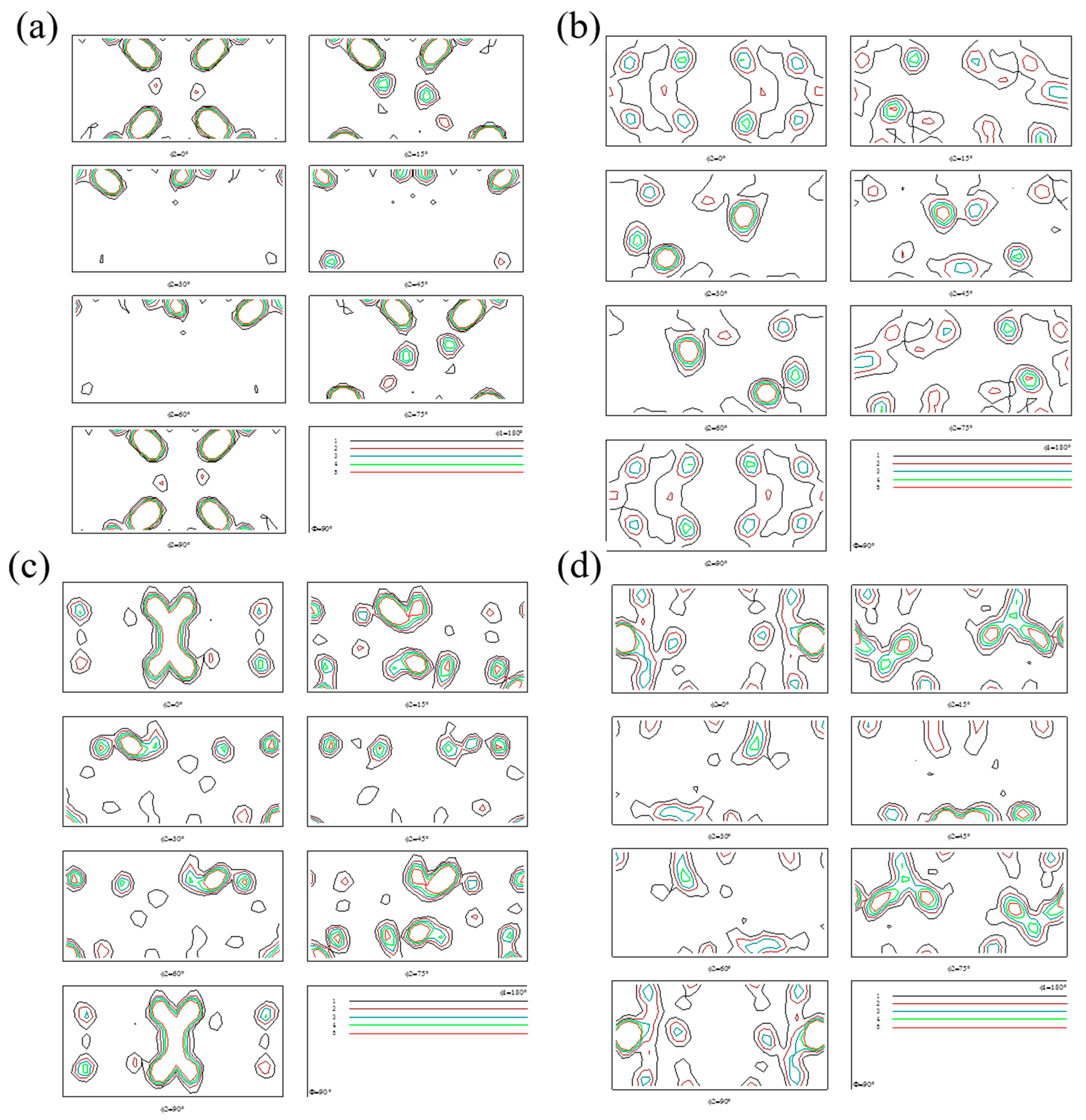


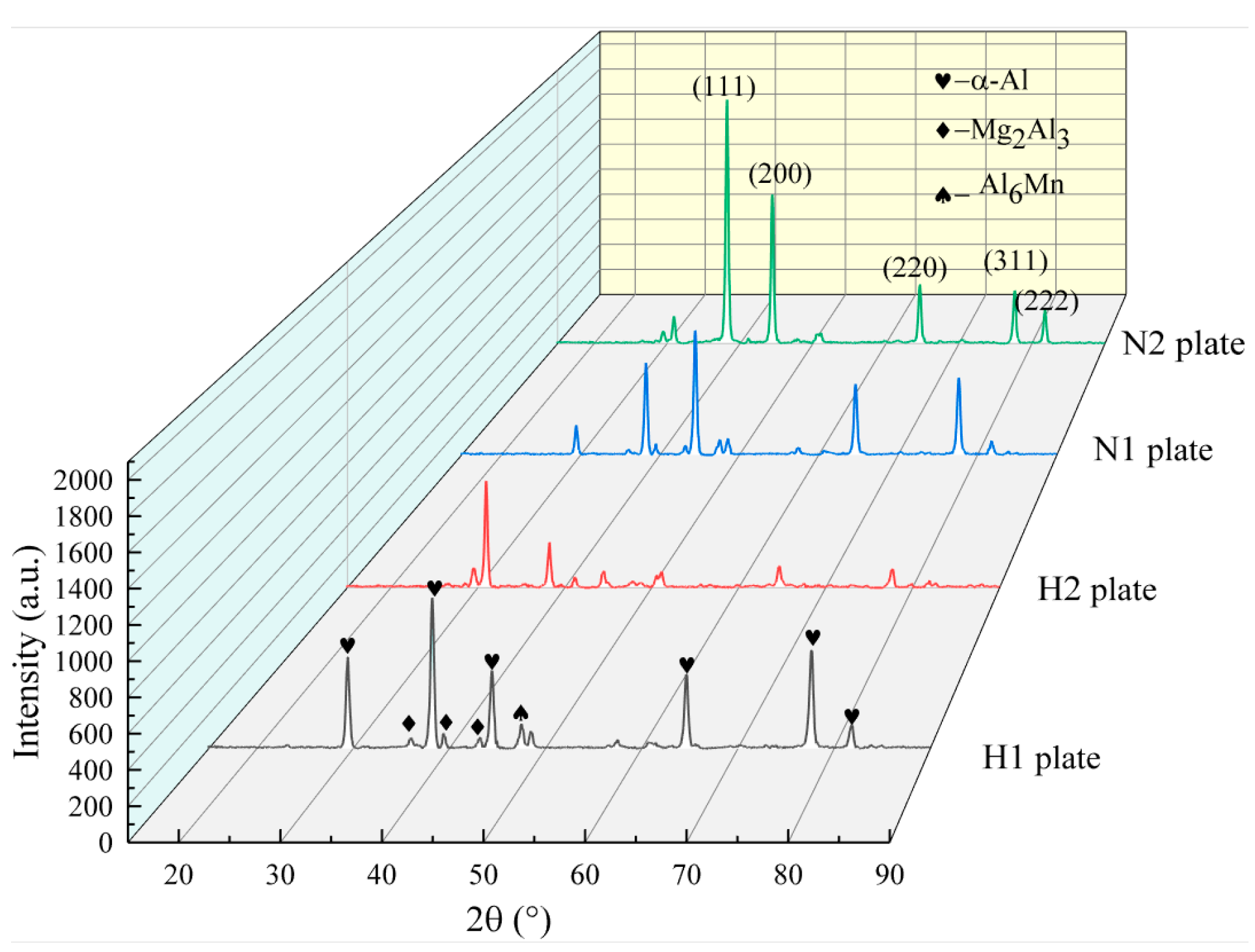
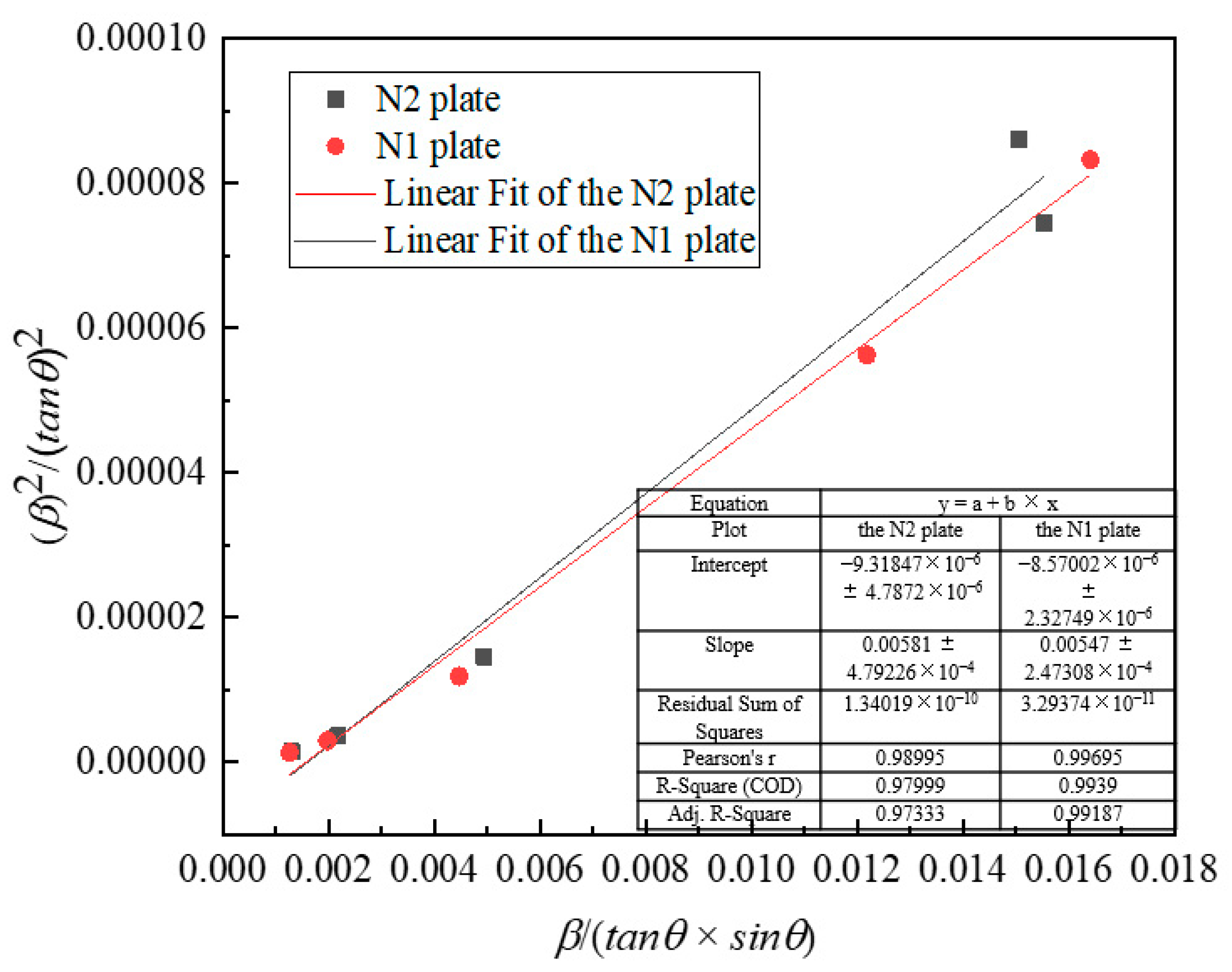
| Composition | Si | Fe | Mn | Mg | Zn | Ti | Zr | Al |
|---|---|---|---|---|---|---|---|---|
| wt.% | 0.0167 | 0.0229 | 0.9318 | 5.6374 | 0.0023 | 0.0084 | 0.1175 | Bal. |
| HKL | N1 Plate | N2 Plate | ||||||
|---|---|---|---|---|---|---|---|---|
| 2θ | d | I% | FWHM | 2θ | d | I% | FWHM | |
| (111) | 38.221 | 2.3528 | 100 | 0.412 | 38.240 | 2.3516 | 100 | 0.390 |
| (200) | 44.441 | 2.0369 | 52.5 | 0.422 | 44.481 | 2.0351 | 21.1 | 0.521 |
| (220) | 64.622 | 1.4411 | 48.7 | 0.417 | 64.681 | 1.4399 | 22.6 | 0.460 |
| (311) | 77.642 | 1.2287 | 70.5 | 0.451 | 77.701 | 1.2279 | 22.8 | 0.495 |
| (222) | 81.842 | 1.1760 | 17.3 | 0.463 | 81.922 | 1.1750 | 7.2 | 0.471 |
Publisher’s Note: MDPI stays neutral with regard to jurisdictional claims in published maps and institutional affiliations. |
© 2022 by the authors. Licensee MDPI, Basel, Switzerland. This article is an open access article distributed under the terms and conditions of the Creative Commons Attribution (CC BY) license (https://creativecommons.org/licenses/by/4.0/).
Share and Cite
Yang, L.; Wang, X.; Yu, F.; Sun, W.; Li, L.; Cui, J. Effects of Gradient Hot Rolled Deformation on Texture Evolution and Properties of 1561 Aluminum Alloy. Crystals 2022, 12, 229. https://doi.org/10.3390/cryst12020229
Yang L, Wang X, Yu F, Sun W, Li L, Cui J. Effects of Gradient Hot Rolled Deformation on Texture Evolution and Properties of 1561 Aluminum Alloy. Crystals. 2022; 12(2):229. https://doi.org/10.3390/cryst12020229
Chicago/Turabian StyleYang, Lingfei, Xiangjie Wang, Fang Yu, Wei Sun, Lei Li, and Jianzhong Cui. 2022. "Effects of Gradient Hot Rolled Deformation on Texture Evolution and Properties of 1561 Aluminum Alloy" Crystals 12, no. 2: 229. https://doi.org/10.3390/cryst12020229






